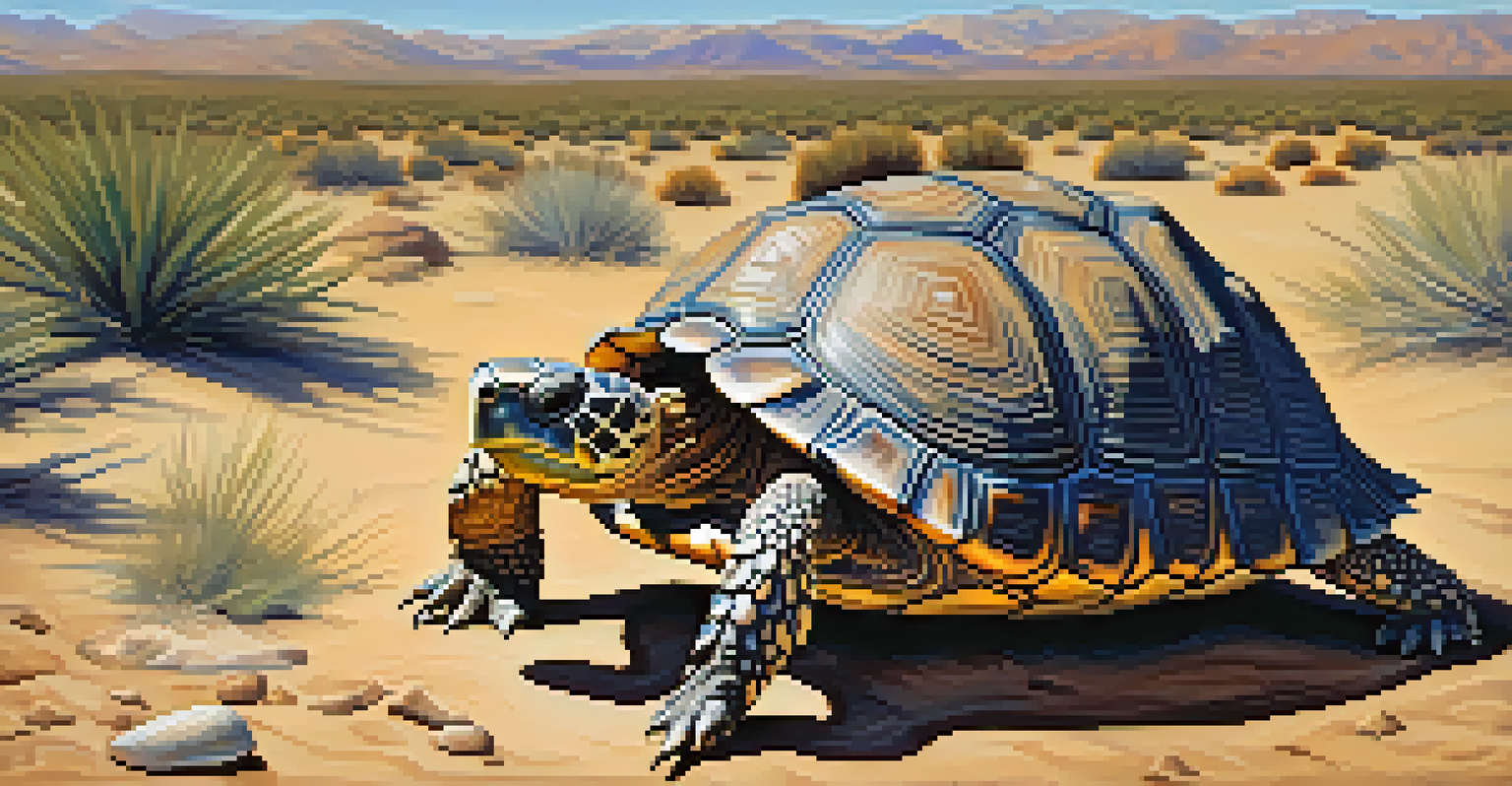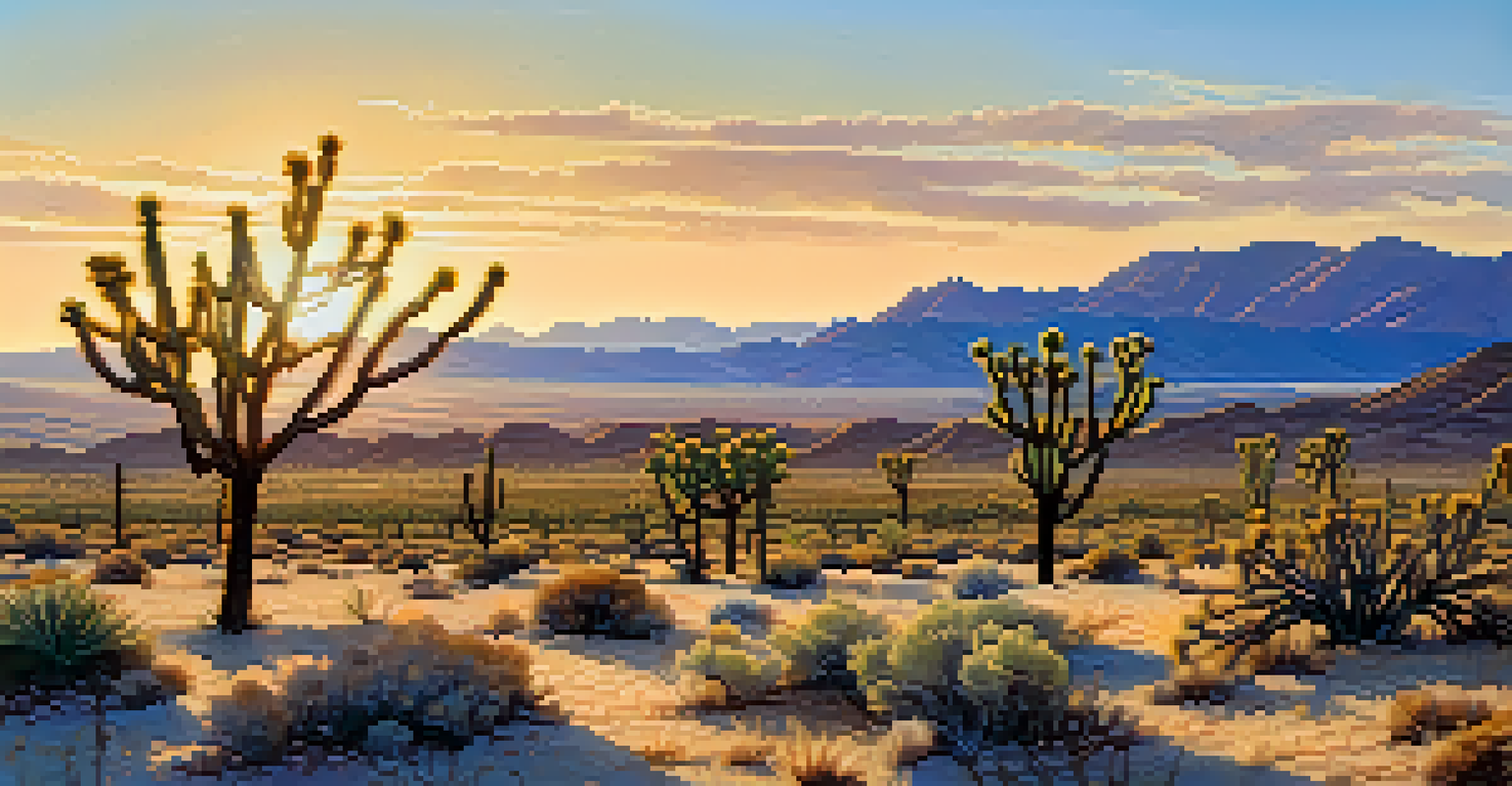How Climate Change Alters Arizona's Desert Ecosystems

Understanding Arizona's Unique Desert Ecosystems
Arizona is home to a rich tapestry of desert ecosystems, including the Sonoran and Mojave deserts. These ecosystems are characterized by diverse plant and animal life, adapted to thrive in arid conditions. The dramatic landscapes, dotted with iconic saguaro cacti and resilient wildlife, are not just beautiful; they play crucial roles in local and global ecological health.
In nature, nothing exists alone.
However, these delicate ecosystems are increasingly threatened by climate change. Rising temperatures, shifting precipitation patterns, and extreme weather events are altering the natural balance. As these changes unfold, the survival of many species and the integrity of these unique habitats hang in the balance.
By understanding the intricacies of Arizona's desert ecosystems, we can better appreciate what is at stake. It’s not just about the cacti and coyotes; it’s about the intricate web of life that sustains them and the ecosystems that provide us with clean air and water.
Rising Temperatures and Their Impact
One of the most immediate effects of climate change is the rise in temperatures across Arizona. Average temperatures are projected to increase by several degrees over the coming decades, leading to hotter summers and milder winters. This shift can be particularly challenging for native species that are adapted to specific temperature ranges.

For instance, species such as the desert tortoise and various reptiles depend on precise thermal conditions for their survival. A significant temperature increase can disrupt their breeding cycles and feeding habits, causing population declines. Moreover, hotter temperatures can lead to increased evaporation rates, further stressing water resources in an already arid environment.
Climate Change Threatens Ecosystems
Arizona's deserts face significant threats from rising temperatures and shifting precipitation patterns, impacting both wildlife and plant life.
In addition to wildlife, the rise in temperatures affects plant life as well. Many desert plants may struggle to survive under extreme heat, which could lead to shifts in vegetation patterns and loss of biodiversity. This, in turn, affects the entire food web, impacting species that rely on these plants for food and habitat.
Shifting Precipitation Patterns
Climate change is not just about rising temperatures; it also brings alterations in precipitation patterns. In Arizona, we’re seeing changes in the timing and intensity of rainfall, which can disrupt seasonal growth cycles. Some areas may experience heavier downpours while others suffer from prolonged droughts, creating an unpredictable environment for both flora and fauna.
The earth does not belong to us: we belong to the earth.
This variability in rainfall can lead to periods of flooding followed by drought, which stresses ecosystems that are already adapted to extreme conditions. For example, heavy rains can cause flash floods, uprooting young plants and washing away nutrients from the soil. Conversely, drought conditions can lead to water scarcity, impacting species that rely on consistent water sources.
Such changes not only threaten the survival of many plant and animal species but also affect human communities. Farmers, for instance, may struggle to grow crops in the face of inconsistent rainfall, leading to food insecurity and economic challenges. Understanding these shifts is crucial for developing strategies to mitigate their impacts.
Effects on Wildlife and Biodiversity
The impacts of climate change on Arizona’s desert ecosystems are particularly evident in wildlife populations. Many species are experiencing habitat loss as the climate shifts, leading to changes in their distribution. Animals such as the desert bighorn sheep and various bird species may find it increasingly difficult to find suitable habitats as their traditional ranges shift.
With species like the cactus ferruginous pygmy owl facing habitat degradation, the loss of biodiversity becomes a pressing concern. When one species is affected, it often triggers a ripple effect throughout the ecosystem, threatening other species that depend on them for food or habitat. This interconnectedness highlights the fragility of desert ecosystems in the face of climate change.
Invasive Species Disrupt Balance
The introduction of invasive species, fueled by climate change, poses a serious risk to the survival of native flora and fauna in Arizona.
Moreover, some species may struggle to adapt quickly enough to the changing conditions, leading to population declines or even extinction. Protecting these vulnerable species is essential for maintaining the ecological balance and ensuring that Arizona's rich biodiversity continues to thrive.
Invasive Species and Climate Change
Another pressing issue related to climate change is the rise of invasive species in Arizona’s desert ecosystems. Warmer temperatures and altered rainfall patterns create ideal conditions for non-native species to thrive, often outcompeting local flora and fauna. This can lead to a significant imbalance in the ecosystem and threaten the survival of native species.
For example, invasive grasses can proliferate in disturbed areas, leading to increased fire risks that can devastate native plant communities. These fires can create a cycle that favors invasive species over native ones, further destabilizing the ecosystem. As these invaders spread, they alter habitats, making it increasingly difficult for native species to survive.
Addressing the challenges posed by invasive species requires a multi-faceted approach that includes monitoring, management, and community education. By understanding how climate change facilitates the spread of these invaders, we can better protect Arizona’s unique desert ecosystems from further degradation.
The Role of Conservation Efforts
In the face of climate change, conservation efforts have become more crucial than ever for protecting Arizona’s desert ecosystems. Organizations and local communities are working tirelessly to develop strategies that enhance resilience and restore habitats. These efforts include habitat restoration, species monitoring, and public education about the importance of native biodiversity.
For instance, initiatives to reintroduce native plants can help restore balance in the ecosystem while providing essential resources for wildlife. Similarly, protecting existing natural areas from development and pollution plays a vital role in conserving biodiversity. By focusing on these efforts, we can create a more sustainable environment for both wildlife and humans.
Conservation Efforts Are Crucial
Proactive conservation initiatives are essential to restore habitats and ensure the sustainability of Arizona's unique desert ecosystems.
Moreover, engaging the community in conservation efforts fosters a sense of stewardship and responsibility. When people understand the intrinsic value of their natural surroundings, they are more likely to take action to protect them. This collective effort is essential in combating the effects of climate change and ensuring that Arizona's desert ecosystems can thrive for future generations.
Looking Ahead: The Future of Arizona's Deserts
As climate change continues to reshape Arizona's desert ecosystems, it is essential to remain proactive in addressing these challenges. The future of these unique environments depends on our ability to adapt and implement effective strategies for conservation and sustainability. Monitoring ongoing changes and understanding their impacts will be crucial in guiding our efforts moving forward.
Additionally, fostering collaboration among scientists, conservationists, and local communities can lead to innovative solutions. By sharing knowledge and resources, we can develop a more comprehensive approach to protecting Arizona's deserts from the threats of climate change. This collaborative spirit can inspire new ideas and actions that make a real difference.

Ultimately, the resilience of Arizona's desert ecosystems hinges on our commitment to understanding and addressing the impacts of climate change. If we work together, we can ensure that these diverse and beautiful landscapes continue to thrive, supporting both wildlife and human communities for generations to come.